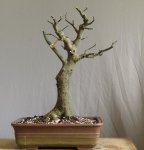Manmountain526
Mame
I am contemplating placing a couple of my Japanese maples in colanders or something similar this spring and placing them in the ground for a bit. I have limited space in which to do so in my backyard. I would have to make a small area to plant the trees and make a bed of some sort to keep the dogs out of it. How far apart do I need to plant the trees for them to do their thing?
Also placing them in colanders and then burying them in topsoil is the way to go correct?
Also placing them in colanders and then burying them in topsoil is the way to go correct?



